A Fox2-dependent fatty acid ß-oxidation pathway coexists both in peroxisomes and mitochondria of the ascomycete yeast Candida lusitaniae
- PMID: 25486052
- PMCID: PMC4259357
- DOI: 10.1371/journal.pone.0114531
A Fox2-dependent fatty acid ß-oxidation pathway coexists both in peroxisomes and mitochondria of the ascomycete yeast Candida lusitaniae
Abstract
It is generally admitted that the ascomycete yeasts of the subphylum Saccharomycotina possess a single fatty acid ß-oxidation pathway located exclusively in peroxisomes, and that they lost mitochondrial ß-oxidation early during evolution. In this work, we showed that mutants of the opportunistic pathogenic yeast Candida lusitaniae which lack the multifunctional enzyme Fox2p, a key enzyme of the ß-oxidation pathway, were still able to grow on fatty acids as the sole carbon source, suggesting that C. lusitaniae harbored an alternative pathway for fatty acid catabolism. By assaying 14Cα-palmitoyl-CoA consumption, we demonstrated that fatty acid catabolism takes place in both peroxisomal and mitochondrial subcellular fractions. We then observed that a fox2Δ null mutant was unable to catabolize fatty acids in the mitochondrial fraction, thus indicating that the mitochondrial pathway was Fox2p-dependent. This finding was confirmed by the immunodetection of Fox2p in protein extracts obtained from purified peroxisomal and mitochondrial fractions. Finally, immunoelectron microscopy provided evidence that Fox2p was localized in both peroxisomes and mitochondria. This work constitutes the first demonstration of the existence of a Fox2p-dependent mitochondrial β-oxidation pathway in an ascomycetous yeast, C. lusitaniae. It also points to the existence of an alternative fatty acid catabolism pathway, probably located in peroxisomes, and functioning in a Fox2p-independent manner.
Conflict of interest statement
Figures
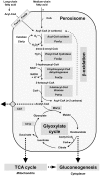
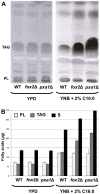
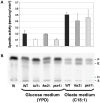


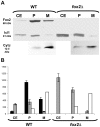
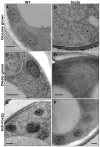
Similar articles
-
Peroxisomal fatty acid beta-oxidation is not essential for virulence of Candida albicans.Eukaryot Cell. 2006 Nov;5(11):1847-56. doi: 10.1128/EC.00093-06. Epub 2006 Sep 8. Eukaryot Cell. 2006. PMID: 16963628 Free PMC article.
-
Repercussion of a deficiency in mitochondrial ß-oxidation on the carbon flux of short-chain fatty acids to the peroxisomal ß-oxidation cycle in Aspergillus nidulans.Biochim Biophys Acta. 2010 Dec;1801(12):1386-92. doi: 10.1016/j.bbalip.2010.08.008. Epub 2010 Aug 21. Biochim Biophys Acta. 2010. PMID: 20736083
-
The activity of the glyoxylate cycle in peroxisomes of Candida albicans depends on a functional beta-oxidation pathway: evidence for reduced metabolite transport across the peroxisomal membrane.Microbiology (Reading). 2008 Oct;154(Pt 10):3061-3072. doi: 10.1099/mic.0.2008/020289-0. Microbiology (Reading). 2008. PMID: 18832312
-
Peroxisomes and beta-oxidation of long-chain unsaturated carboxylic acids.Scand J Clin Lab Invest Suppl. 1991;204:33-46. doi: 10.3109/00365519109104593. Scand J Clin Lab Invest Suppl. 1991. PMID: 2042025 Review.
-
Peroxisomal beta-oxidation and peroxisome proliferator-activated receptor alpha: an adaptive metabolic system.Annu Rev Nutr. 2001;21:193-230. doi: 10.1146/annurev.nutr.21.1.193. Annu Rev Nutr. 2001. PMID: 11375435 Review.
Cited by
-
A Saccharomyces cerevisiae knockout screen for genes critical for growth under sulfur- and nitrogen-limited conditions reveals intracellular sorting via vesicular transport systems.G3 (Bethesda). 2025 Jul 9;15(7):jkaf074. doi: 10.1093/g3journal/jkaf074. G3 (Bethesda). 2025. PMID: 40205732 Free PMC article.
-
Genomic factors limiting the diversity of Saccharomycotina plant pathogens.bioRxiv [Preprint]. 2025 Feb 28:2025.02.27.640420. doi: 10.1101/2025.02.27.640420. bioRxiv. 2025. Update in: G3 (Bethesda). 2025 Aug 12:jkaf184. doi: 10.1093/g3journal/jkaf184. PMID: 40060456 Free PMC article. Updated. Preprint.
-
Oleic acid metabolism via a conserved cytochrome P450 system-mediated ω-hydroxylation in the bark beetle-associated fungus Grosmannia clavigera.PLoS One. 2015 Mar 20;10(3):e0120119. doi: 10.1371/journal.pone.0120119. eCollection 2015. PLoS One. 2015. PMID: 25794012 Free PMC article.
-
Peroxisomes regulate virulence and cell density sensing in Cryptococcus neoformans.bioRxiv [Preprint]. 2025 May 14:2025.05.14.654083. doi: 10.1101/2025.05.14.654083. bioRxiv. 2025. PMID: 40654974 Free PMC article. Preprint.
-
Roles of Peroxisomes in the Rice Blast Fungus.Biomed Res Int. 2016;2016:9343417. doi: 10.1155/2016/9343417. Epub 2016 Aug 16. Biomed Res Int. 2016. PMID: 27610388 Free PMC article. Review.
References
-
- Brock M (2009) Fungal metabolism in host niches. Curr Opin Microbiol 12:371–376. - PubMed
-
- Hiltunen JK, Mursula AM, Rottensteiner H, Wierenga RK, Kastaniotis AJ, et al. (2003) The biochemistry of peroxisomal beta-oxidation in the yeast Saccharomyces cerevisiae . FEMS Microbiol Rev 27:35–64. - PubMed
-
- Moreno de la Garza M, Schultz-Borchard U, Crabb JW, Kunau W-H (1985) Peroxisomal beta-oxidation system of Candida tropicalis . Eur J Biochem 148:285–291. - PubMed
Publication types
MeSH terms
Substances
LinkOut - more resources
Full Text Sources
Other Literature Sources

